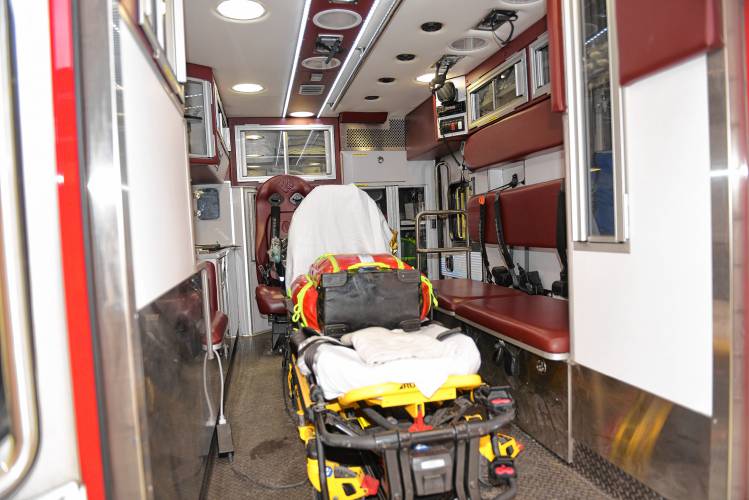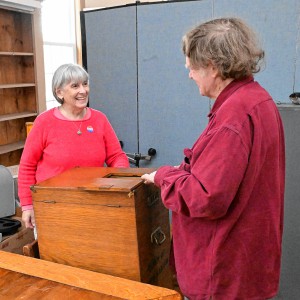What are the protocols for emergency transport of infants?

The interior of an Orange Fire Rescue EMS ambulance, pictured at the Orange Fire Station. STAFF PHOTO/PAUL FRANZ
|
Published: 04-26-2024 3:11 PM
Modified: 04-26-2024 6:38 PM |
When it comes to protocols for providing emergency medical transportation to infants, the Massachusetts Office of Emergency Medical Services, the National Highway Traffic Safety Administration and ambulance manufacturers voice similar expectations.
But is there a point where a baby is too small to be safely transported in an ambulance? This is a question that played into decision-making during a Jan. 4 ambulance call in New Salem, where Mark Fortier, in his capacity as captain of Orange EMS, advised the mother of a 2-week-old infant that it would be safer to drive her baby to the hospital by herself, with the child secured in his car seat. Fortier’s alleged failure to transport the infant prompted the Office of Emergency Medical Services to suspend his license in February.
According to the state’s investigation of the call, the mother said during an interview with the state Department of Public Health that she had called for an ambulance on Jan. 4 after her baby became “lethargic” and “limp in her arms.” The mother reportedly told dispatchers that her child “keeps choking and not breathing. He acts like he is going to pass out and stops breathing …” The mother described her 2-week-old child as having “some blue color to his lips” and said he was born with some “lung problems.”
Fortier reportedly told the state DPH that while he didn’t conduct a physical assessment of the child upon his arrival, the baby showed no signs of “abnormal” breathing, didn’t feel feverish and his skin color appeared normal. While the mother wanted her child transported to Baystate Franklin Medical Center’s emergency room in Greenfield, Fortier advised that the pediatric restraint device on the ambulance is good for infants 10 pounds or greater, and he said the child “did not look to weigh 10 pounds.” Therefore, Fortier thought it would be safer for the mother to drive her baby to the hospital by herself, with the child secured in his car seat, according to state regulators.
Under Protocol 7.4 of the Statewide Treatment Protocols, “An ill or injured child must be restrained in a manner that minimizes injury in an ambulance crash. The best location for transporting a pediatric patient is on the ambulance cot. The method of restraint will be determined by various circumstances, including the child’s medical condition and weight.” DPH states in its investigatory report that due to these protocols, “EMTs at all levels of certification are to transport infants and pediatric patients as safely as possible.”
An EMT is supposed to use an appropriately sized five-point harness that’s secured to the ambulance stretcher per manufacturers’ recommendations, the state’s report reads. If the child weighs less than 10 pounds, then accommodations must be made such as applying extra padding around the child or using more straps to secure the infant’s car seat to the stretcher.
The National Highway Traffic Safety Administration (NHTSA) provides a similar explanation in its document, “Working Group Best-Practice Recommendations for the Safe Transportation of Children in Emergency Ground Ambulances.”
Children weighing between 5 and 20 pounds must lie flat in the ambulance and should be secured on the ambulance cot using a car bed with two belt systems. The second set of loops must be purchased from the manufacturer, the NHTSA document reads. The cot backrest must be elevated to the fully upright position and the belts must be attached to the cot to minimize sliding.
Article continues after...
Yesterday's Most Read Articles
 Bridge of Flowers in Shelburne Falls to open on plant sale day, May 11
Bridge of Flowers in Shelburne Falls to open on plant sale day, May 11
 Serious barn fire averted due to quick response in Shelburne
Serious barn fire averted due to quick response in Shelburne
 $12.14M school budget draws discussion at Montague Town Meeting
$12.14M school budget draws discussion at Montague Town Meeting
 As I See It: Between Israel and Palestine: Which side should we be on, and why?
As I See It: Between Israel and Palestine: Which side should we be on, and why?
 Greenfield homicide victim to be memorialized in Pittsfield
Greenfield homicide victim to be memorialized in Pittsfield
 ‘We are among the leaders’: Ashfield Town Meeting voters pass bevy of clean energy proposals
‘We are among the leaders’: Ashfield Town Meeting voters pass bevy of clean energy proposals
The DPH reportedly told Fortier, a certified paramedic for 13 years, during an interview about the Jan. 4 call that “when EMTs are faced with transporting patients who are small infants, it is common practice to find the safest way to accommodate their size using their own car seat or the pediatric restraint device on the ambulance.”
Dr. Jonathan Burstein, who completed a clinical review of the Jan. 4 incident involving Fortier, referenced 105 CMR 170.355, which declares the ambulance service’s responsibility to dispatch, treat and transport patients. The regulation states that “no service or agent thereof, including but not limited to its EMS personnel, shall refuse in the case of an emergency to dispatch an available EMS vehicle and to provide emergency response, assessment and treatment within the service’s regular operating area in accordance with the Statewide Treatment Protocols ...” Burstein also mentioned Statewide Treatment Protocol 1.0 on general patient care, which states that EMS should “operate the ambulance stretcher in accordance with your service training and manufacturer’s specifications at all times.”
“There is no pathway provided for [an ambulance] service or EMT of any kind to refuse care or transport, as was done here,” Burstein wrote about the incident, according to state documents.
According to the DPH documents, Burstein advised an immediate option would be to use the baby’s car seat and secure it in the technician seat in the patient compartment or on the stretcher, or call for another ambulance to bring appropriate equipment if, in fact, the responding ambulance did not have the equipment.
Chris Gagnon, director of ambulance sales at North Attleborough-based Greenwood Emergency Vehicles, which sells emergency vehicles throughout New England including to Northfield EMS, said that all ambulances sold in Massachusetts are expected to abide by the U.S. General Services Administration guidelines. Those guidelines include a policy that states “all cots and infant transporters should only be used with the required fastener assembly as prescribed by the cot/transporter manufacturer.”
According to a spokesperson from the NHTSA, which enforces vehicle performance standards and partnerships with state and local governments in an effort to reduce deaths, injuries and economic losses from crashes, “All ground ambulances transporting children should have seats and restraints capable of safely securing children. These can be in the form of either a single system or multiple restraints as long as all sizes are accommodated.”
The NHTSA also advises that “a child passenger, especially a newborn, must never be transported on an adult’s lap. Newborns must always be transported in an appropriate child restraint system. Never allow anyone to hold a newborn during transport.”

 New Salem election ushers in new Selectboard member
New Salem election ushers in new Selectboard member Community Legal Aid expands Disability Benefits Project to Franklin County
Community Legal Aid expands Disability Benefits Project to Franklin County Wear Orange organizers prepare display to remember gun violence victims
Wear Orange organizers prepare display to remember gun violence victims
